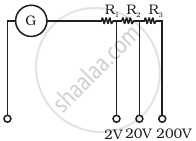Advertisements
Advertisements
प्रश्न
Why does a galvanometer when connected in series with a capacitor show a momentary deflection, when it is being charged or discharged?
How does this observation lead to modifying the Ampere's circuital law?
Hence write the generalised expression of Ampere's law.
उत्तर
During charging and discharging of the capacitor, there is a flow of charge from the battery towards the plates of the capacitor, which produces a conduction current in the circuit. Hence, the galvanometer present in the circuit shows momentary deflection.
As the charge on the capacitor grows, the conduction current in the wires increases. When the capacitor is fully charged, the conduction current stops flowing in the wires. During charging or discharging of the capacitor, there is no conduction current between the plates of capacitor, as they are not connected by any conduction material. Therefore, in this region, a current must exist that makes the total current in the circuit continuous. This observation leads to modifying the Ampere's circuital law.
Thus, there must be displacement current along with the conduction current in the circuit having the property of continuity, although individually they may not be continuous.
Maxwell modified Ampere's circuital law in order to make it logically consistent. He stated Ampere's circuital law in the form,
This is the generalised expression of Ampere's law.
APPEARS IN
संबंधित प्रश्न
A rectangular coil of a moving coil galvanometer contains 50 turns each having area 12 cm2 . It is suspended in radial magnetic field 0.025 Wb/m2 by a fibre of twist constant 15 x10-10 Nm/degree. Calculate the sensitivity of the moving coil galvanometer.
A circular coil of 250 turns and diameter 18 cm carries a current of 12A. What is the magnitude of magnetic moment associated with the coil?
State the principle of the working of a moving coil galvanometer, giving its labeled diagram ?
Outline the necessary steps to convert a galvanometer of resistance RG into an ammeter of a given range ?
A galvanometer coil has a resistance of 12 Ω and the metre shows full scale deflection for a current of 3 mA. How will you convert the metre into a voltmeter of range 0 to 18 V?
Assertion (A): On Increasing the current sensitivity of a galvanometer by increasing the number of turns may not necessarily increase its voltage sensitivity.
Reason (R): The resistance of the coil of the galvanometer increases on increasing the number of turns.
Select the most appropriate answer from the options given below:
A multirange voltmeter can be constructed by using a galvanometer circuit as shown in figure. We want to construct a voltmeter that can measure 2V, 20V and 200V using a galvanometer of resistance 10Ω and that produces maximum deflection for current of 1 mA. Find R1, R2 and R3 that have to be used.

A moving coil galvanometer has 150 equal divisions. Its current sensitivity is 10-divisions per milliampere and voltage sensitivity is 2 divisions per millivolt. In order that each division reads 1 volt, the resistance in ohms needed to be connected in series with the coil will be ______.
How is current sensitivity increased?
A voltmeter has a range of 0 - 20 V and a resistance of 500 Q. Explain how can be used to measure voltages from 0 - 200 volt?
